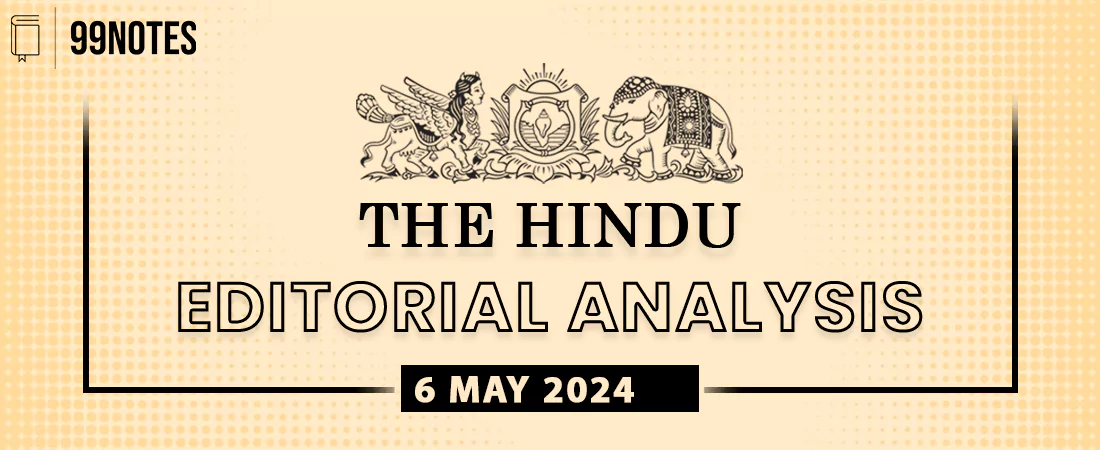6 May 2024 : The Hindu Editorial Notes PDF
1. It is time to operationalise the Indian Defence University
| Topic: GS2 – Governance – Government policies – Issues arising out of their design & implementation |
| Context |
| ● The article discusses the necessity of establishing the Indian Defence University (IDU) to enhance the country’s defence preparedness and strategic thinking.
● It highlights the historical background of the IDU proposal, the challenges in the current professional military education system, and the urgency of the establishment of Indian Defence University (IDU). |
Introduction:
- In an era of dynamic warfare and evolving security challenges, the establishment of dedicated defence universities has become a global trend.
- However, India’s lack of an equivalent institution, such as the Indian Defence University (IDU), poses significant concerns for its defence preparedness. Countries like Pakistan and China have already established defence universities.
- This analysis delves into the historical background, challenges in the current professional military education system, and the urgent need to operationalize IDU to bolster India’s strategic acumen and national security capabilities.
Professional Military Education (PME):
- The evolving nature of warfare necessitates a robust Professional Military Education (PME) system.
- The U.S. serves as a model, with significant reforms initiated by the Goldwater-Nichols Defense Reorganisation Act and ‘Ike’ Skelton’s recommendations to enhance military education.
- Indian armed forces require a comprehensive education system emphasising academic rigour to address contemporary security challenges effectively.
Historical Context:
- The idea of an Indian Defence University (IDU) dates back to 1967 when the Chiefs of Staff Committee proposed its establishment.
- After the Kargil conflict, a committee chaired by Dr. K. Subrahmanyam recommended the creation of IDU.
- Despite initial approval in 2010, progress on establishing IDU has been slow, hindering the development of a unified Professional Military Education (PME) framework.
Challenges in Current System:
- While India boasts world-class training institutions, there is a lack of an integrated Professional Military Education (PME) framework and interdisciplinary approach to strategic thinking.
- Affiliations with universities for degree courses do not adequately address military education requirements.
Purpose and Structure of IDU:
- IDU aims to bridge existing gaps in Professional Military Education (PME) by providing higher military education with a qualified faculty comprising academics, serving, and retired military officers.
- The curriculum of IDU would encompass diverse subjects relevant to national security and defence, blending theory with practical application.
Misconceptions about Rashtriya Raksha University (RRU):
- Comparing Indian Defence University (IDU) with Rashtriya Raksha University (RRU) is inappropriate as their objectives and curricula differ significantly.
- RRU’s focus is not solely on military requirements for war management and plan execution.
Urgency of Establishing IDU:
- Delays in commissioning IDU undermine defence preparedness, strategic culture, and inter-service integration.
- Operationalizing IDU is imperative to lay the foundation for joint warfighting through a forward-looking military education curriculum.
Conclusion:
- The establishment of IDU is long overdue, and its realisation is critical for enhancing India’s defence preparedness and strategic acumen.
- Prompt action is required to initiate IDU and develop a curriculum aligned with contemporary security challenges and the evolving nature of warfare.
| Importance of Indian Defence University (IDU) in strengthening the country’s defence capabilities and strategic planning |
| Importance:
● Enhances Defense Preparedness: IDU serves as a crucial institution to prepare military officers for contemporary security challenges, ensuring readiness in defence operations. ● Fosters Strategic Thinking: By providing a comprehensive education system, IDU cultivates strategic thinking among officers, enabling them to anticipate and adapt to evolving threats effectively. ● Promotes Inter-Service Integration: IDU facilitates collaboration and synergy among different branches of the armed forces, leading to better coordination and joint warfighting capabilities. ● Addresses Deficiencies in Current System: India’s fragmented professional military education system lacks an integrated framework. IDU fills this gap by offering a centralised institution focusing on academic rigour and practical application. ● Incorporates Multidisciplinary Approach: With a diverse curriculum covering subjects relevant to national security and defence, IDU equips officers with a holistic understanding of defence strategy, combining theory with practice. ● Supports Defence Modernization: IDU plays a pivotal role in aligning military education with technological advancements and modern warfare tactics, ensuring that the armed forces remain agile and adaptive. ● Strengthens National Security: By producing well-trained and strategically-minded officers, IDU contributes significantly to bolstering India’s overall defence capabilities, safeguarding the nation against external threats and challenges. Challenges: ● Fragmented Education System: India’s military education landscape is characterised by disparate institutions, lacking a unified framework for professional military education. ● Lack of Interdisciplinary Approach: Current institutions primarily focus on technical and operational aspects, neglecting the interdisciplinary nature of modern warfare and strategic thinking. ● Insufficient Academic Rigour: Many existing military training establishments lack the academic depth required to address contemporary security challenges adequately. ● Limited Civil-Military Integration: There is a gap between military and civilian expertise, hindering comprehensive strategic planning and decision-making. ● Slow Progress in Establishing IDU: Despite initial approval in 2010, the establishment of the Indian Defence University (IDU) has faced delays, prolonging the absence of a centralised institution for higher military education. ● Resource Allocation: Allocating sufficient resources, including funding and qualified faculty, poses a significant challenge in establishing and maintaining a comprehensive defence university like IDU. |
| Practice Question: Explain the importance of Indian Defence University (IDU) in strengthening the country’s defence capabilities and strategic planning. (150 Words /10 marks) |
2. Make the poor richer without making the rich poorer
| Topic: GS3 – Indian Economy – Inclusive Growth |
| Context |
| ● The article explores the recent election discourse in India, centering on the concept of “redistribution” following the Congress party’s manifesto release.
● It delves into the widening economic disparity globally and proposes a pragmatic approach to bridge the gap by maximising economic growth, reforming taxation, and implementing social welfare programs. |
Introduction:
- The recent election discourse in India has centred around the concept of “redistribution” following the release of the Congress party’s manifesto.
- Despite Prime Minister Narendra Modi’s allegations, the manifesto does not explicitly mention redistribution, mangalsutras, or wealth tax.
- However, this has ignited a significant debate on India’s inequality and the strategies to bridge the wealth gap.
Understanding Economic Disparity:
- Over the past two decades, economic inequality has widened considerably globally, including in India.
- Politicising this issue detracts from the urgent need to address the growing wealth gap.
- The core debate revolves around how to create a more equitable and just society.
Approaches to Bridging the Gap:
- Bridging the rich-poor gap can occur by making the rich poorer, the poor richer, or both.
- Developed nations, with slower growth rates, often adopt a “Pareto Optimum” approach, which necessitates making trade-offs between individuals’ welfare, balancing benefits for one person without harming another.
- Developing nations, with faster growth potential, have more flexibility in their approaches to reducing inequality.
Challenges with Wealth Taxation:
- The proposal of a wealth tax aims to extract from the super-rich and redistribute to the poor, reflecting a zero-sum mentality.
- However, taxing wealth acquired through unfair means should not substitute for addressing systemic issues.
- Imposing punitive taxes on the wealthy may hinder investment and capital flight, particularly in a developing economy like India.
Concerns with Inheritance Tax:
- While inheritance tax seems morally justified, it doesn’t significantly impact economic inequality.
- The goal is to reduce wealth disparity, not solely to address ethical dilemmas.
- Vindictive tax measures may not generate substantial resources or foster a conducive economic environment.
Importance of Economic Growth:
- Economic growth is crucial for expanding the overall economic pie, especially in India’s developmental stage.
- Jobless growth and skewed capital-labour dynamics contribute to widening inequality.
- Rebalancing this skew through labour-focused policies is essential for reducing economic disparity.
Taxation Reforms:
- India’s tax system exacerbates inequality, with the burden disproportionately falling on the poor and middle class.
- Tax reforms, such as simplifying GST and introducing a new direct tax code, are imperative to rectify this imbalance.
Social Security and Welfare Programs:
- Social security nets are essential to support the poor until they can benefit from economic growth.
- Funding Social Security programs can be achieved through faster growth, higher tax revenue, and efficient welfare delivery.
Balancing Act for Reducing Inequality:
- A pragmatic approach involves maximising economic growth, minimising unemployment, and lowering the tax burden for the common person.
- It requires a delicate balance of labour market incentives, welfare safety nets, and investment attraction.
- Punitive taxation of the rich is not a sustainable or wise solution, as India can reduce inequality by uplifting the poor without penalising the wealthy.
Conclusion:
- Addressing economic inequality requires a comprehensive strategy that prioritises economic growth, tax reform, and social welfare.
- India’s focus should be on making the poor richer without resorting to punitive measures against the wealthy.
| Inequality in India |
| Inequality Trends in India:
● Wealth Inequality: Top 10% own 77% of national wealth; poorest half have only 4.1%. ● Income Inequality: Top 10% and 1% hold 57% and 22% of total income respectively; bottom 50% share reduced to 13%. ● Tax Burden: 64% of GST from bottom 50%; only 4% from top 10%. ● Global Hunger Index: India’s score at 28.7, considered serious; highest child-wasting rate. ● Healthcare Accessibility: 63 million pushed into poverty annually due to healthcare costs; majority unable to access needed care. (Source – The Economic Times, December 7, 2022) Causes of Increasing Inequality in India: ● Unequal Access to Education: Disparities in educational opportunities perpetuate socio-economic inequalities, limiting upward mobility for marginalised communities. ● Informal Sector Dominance: The dominance of the informal sector in India’s economy leads to low wages, insecure employment, and lack of social protection, exacerbating income disparities. ● Unequal Distribution of Wealth: Concentration of wealth among a small elite contributes to widening income gaps and socio-economic inequalities. ● Caste and Gender Discrimination: Persistent caste-based and gender-based discrimination marginalise certain groups, limiting their access to opportunities and resources. ● Urban-Rural Divide: Disparities between urban and rural areas in terms of infrastructure, employment opportunities, and access to basic services widen income and wealth gaps. Way Forward: ● Investment in Education: Enhance access to quality education and skill development programs to promote equal opportunities for all. ● Job Creation: Implement policies to stimulate job creation, particularly in sectors with high labor-absorptive capacity, to reduce unemployment and underemployment. ● Social Protection: Strengthen social safety nets and welfare programs to provide financial support and assistance to vulnerable populations. ● Progressive Taxation: Introduce progressive tax policies to redistribute wealth and reduce income inequalities. ● Gender and Caste Equality: Promote gender equality and social inclusion through affirmative action policies and measures to address caste-based discrimination. ● Rural Development: Focus on rural development initiatives to bridge the urban-rural divide and promote inclusive growth. |
| PYQ: COVID-19 pandemic accelerated class inequalities and poverty in India. Comment. (150 words/10m) (UPSC CSE (M) GS-1 2020) |
| Practice Question: Discuss the implications of widening economic disparity in India. Analyse the feasibility of various approaches, including taxation reforms and social welfare programs, in bridging the rich-poor gap, with a focus on sustainable economic growth. (250 Words /15 marks) |





